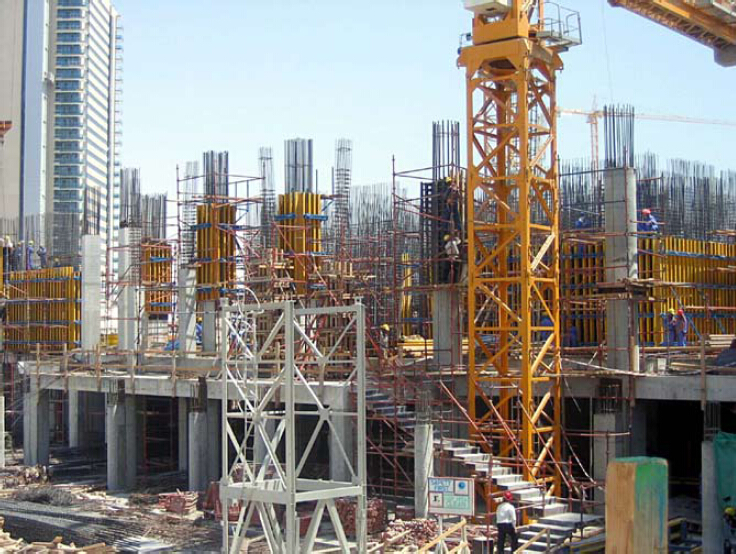Timber Beam for Formwork and Scaffolding system
- Loading Port:
- Tianjin
- Payment Terms:
- TT OR LC
- Min Order Qty:
- 50 m²
- Supply Capability:
- 1000 m²/month
OKorder Service Pledge
Quality Product, Order Online Tracking, Timely Delivery
OKorder Financial Service
Credit Rating, Credit Services, Credit Purchasing
You Might Also Like
Characteristics:
◆ Standardized production lines.
Supply capability: 3000m/day, Lmax = 6600mm.
◆ Finger jointing of the flange and web, the strength of timber beam is highly improved.
Max. shearing force failure load:40KN
◆ Well treated to prevent from water penetration or erosion, so the service life maximally extended.
Normally, CNBM timber beam H20 can be used for 4 to 5 years, the exact using time would depend on maintenance & storage.
◆ Robust caps at the end of the girders protect against damages.


- Q:Are there any environmental considerations when using steel formwork?
- Using steel formwork in construction projects raises several environmental considerations. First and foremost, the production of steel leaves a significant carbon footprint. Greenhouse gas emissions are generated during the extraction and processing of raw materials, such as iron ore and coal. Moreover, the manufacturing process itself requires a substantial amount of energy, further contributing to carbon emissions. In addition, the transportation of steel formwork systems has a negative environmental impact. The movement of heavy steel panels and other components increases fuel consumption and emissions, particularly for long distances. Furthermore, steel formwork is typically non-renewable and non-recyclable. Once it reaches the end of its useful life, it often ends up in landfills, contributing to waste accumulation and environmental pollution. However, it is important to note that steel formwork does have some environmental advantages compared to other materials. For instance, it can be reused multiple times, reducing the need for new materials and minimizing waste generation. Its durability and strength also contribute to a longer lifespan and less frequent replacements, which in turn reduces overall resource consumption. To mitigate the environmental impact of using steel formwork, various measures can be taken. These include optimizing transportation routes to reduce fuel consumption, implementing energy-efficient manufacturing processes, and promoting the recycling of steel formwork components at the end of their life. Additionally, exploring alternative formwork materials, such as recycled or sustainable options, can also help address the environmental considerations associated with steel formwork usage.
- Q:What are the different types of edge protection systems used in steel formwork?
- There are several types of edge protection systems used in steel formwork, including steel guardrails, toeboards, mesh panels, and safety nets. These systems are designed to prevent workers from falling or objects from being dropped off the edges of the formwork, ensuring a safe working environment.
- Q:Can steel formwork be used for both indoor and outdoor construction projects?
- Yes, steel formwork can be used for both indoor and outdoor construction projects. Steel is a durable and versatile material that can withstand different weather conditions, making it suitable for various construction environments.
- Q:Are there any limitations to using steel formwork?
- Yes, there are some limitations to using steel formwork. Firstly, steel formwork is relatively expensive compared to other types of formwork materials such as wood or plastic. This can make it less cost-effective for smaller projects or projects with a limited budget. Secondly, steel formwork is heavy and requires heavy lifting equipment for installation and removal. This can be a challenge in areas with limited access or where cranes and other heavy machinery may not be readily available. Additionally, steel formwork requires skilled labor for proper installation and dismantling. It is important to have experienced workers who are familiar with the use of steel formwork to ensure the safety and effectiveness of the formwork system. Furthermore, steel formwork is susceptible to corrosion if not properly protected. This can be a concern in environments with high humidity or exposure to moisture, requiring additional maintenance and protective measures. Lastly, steel formwork is not as flexible or adaptable as other types of formwork materials. It may not be suitable for complex or irregular shapes and may require more time and effort to customize for specific project requirements. Overall, while steel formwork offers durability and strength, its limitations in terms of cost, weight, labor requirements, susceptibility to corrosion, and flexibility should be considered when choosing the most appropriate formwork system for a specific construction project.
- Q:Can steel formwork be used for infrastructure construction projects?
- Indeed, infrastructure construction projects can make effective use of steel formwork. This option, known for its versatility and durability, proves ideal for a range of infrastructure types including bridges, tunnels, dams, and buildings. Given its strength and rigidity, it can withstand the heavy loads and high pressures commonly associated with such projects. Moreover, its easy dismantling and reusability factor into its cost-effectiveness and sustainability. As an added advantage, steel formwork offers flexibility for customization, enabling precise and accurate construction tailored to specific project requirements. Ultimately, steel formwork stands as a dependable and efficient solution for infrastructure construction projects.
- Q:How does steel formwork handle concrete finishing and curing agents?
- Steel formwork is highly resistant to the chemical agents commonly used in concrete finishing and curing processes. Its durable and non-absorbent surface prevents the concrete from adhering to the formwork, allowing for easy release and smooth finishing of the concrete surface. Additionally, the steel formwork's rigidity and stability ensure that the concrete maintains its desired shape and prevents any deformation during the curing process.
- Q:How does steel formwork handle concrete surface finishing?
- Steel formwork is a popular choice in the construction industry due to its durability, strength, and versatility. When it comes to concrete surface finishing, steel formwork offers several advantages. Firstly, steel formwork provides a smooth and even surface, resulting in a high-quality finish. The rigid nature of steel helps prevent any warping or bending during the pouring and curing process, ensuring that the concrete maintains its desired shape and dimensions. This is particularly important for achieving a level and flat surface, which is essential for many construction applications. Additionally, steel formwork allows for precise control over the concrete pouring process. The tight joints and strong connections in steel formwork prevent any leakage or seepage of the concrete, resulting in a clean and consistent surface finish. This is especially beneficial when working on projects that require a high degree of precision or have specific architectural requirements. Furthermore, steel formwork can be easily customized to create various surface finishes. By incorporating different textures, patterns, or coatings onto the steel panels, contractors can achieve a wide range of aesthetic effects on the concrete surface. This flexibility allows for creativity in design and enhances the overall visual appeal of the finished structure. Lastly, steel formwork is reusable, making it a cost-effective solution for concrete surface finishing. Unlike other types of formwork, such as wood or plastic, steel formwork can be cleaned, repaired, and reused multiple times, reducing material waste and saving on construction costs. This sustainability aspect is becoming increasingly important in the construction industry, as it contributes to a more environmentally friendly and economically viable approach. In conclusion, steel formwork provides excellent support for concrete surface finishing. Its strength, precision, customization options, and reusability make it a preferred choice for achieving high-quality finishes in construction projects. Whether it is a smooth and level surface or an intricately textured design, steel formwork ensures that the concrete surface is finished to the desired specifications.
- Q:Can steel formwork be used for both single-use and multi-use applications?
- Yes, steel formwork can be used for both single-use and multi-use applications. Steel formwork is highly durable and can withstand multiple uses without significant wear or damage. However, it can also be designed and fabricated for single-use applications where it is more cost-effective or practical.
- Q:How does steel formwork affect the overall durability of a structure?
- Steel formwork can significantly enhance the durability of a structure. Due to its robust nature, steel formwork provides excellent support and stability during the construction process. This ensures that the structure maintains its shape and integrity, even when subjected to heavy loads and external forces. Additionally, steel formwork is highly resistant to wear and corrosion, prolonging the lifespan of the structure. Its durability also allows for multiple reuses, reducing construction costs and environmental impact. Overall, the use of steel formwork contributes to the long-term durability and strength of a structure.
- Q:What are the safety considerations when working with steel formwork?
- When working with steel formwork, there are several safety considerations that should be taken into account. First and foremost, workers must ensure that the formwork is properly installed and secured to prevent any collapse or instability. It is essential to follow manufacturer's instructions and guidelines for assembly and disassembly. Additionally, workers should be equipped with proper personal protective equipment (PPE) such as hard hats, gloves, and safety glasses to protect themselves from potential hazards such as falling objects or metal shards. Adequate training and supervision are also crucial to ensure that workers are aware of the potential risks and hazards associated with steel formwork and know how to work safely. Regular inspections of the formwork should be conducted to identify any signs of damage or deterioration that could compromise its structural integrity. Finally, proper communication and coordination among the team members is essential for a safe working environment when using steel formwork.
1. Manufacturer Overview |
|
|---|---|
| Location | |
| Year Established | |
| Annual Output Value | |
| Main Markets | |
| Company Certifications | |
2. Manufacturer Certificates |
|
|---|---|
| a) Certification Name | |
| Range | |
| Reference | |
| Validity Period | |
3. Manufacturer Capability |
|
|---|---|
| a)Trade Capacity | |
| Nearest Port | |
| Export Percentage | |
| No.of Employees in Trade Department | |
| Language Spoken: | |
| b)Factory Information | |
| Factory Size: | |
| No. of Production Lines | |
| Contract Manufacturing | |
| Product Price Range | |
Send your message to us
Timber Beam for Formwork and Scaffolding system
- Loading Port:
- Tianjin
- Payment Terms:
- TT OR LC
- Min Order Qty:
- 50 m²
- Supply Capability:
- 1000 m²/month
OKorder Service Pledge
Quality Product, Order Online Tracking, Timely Delivery
OKorder Financial Service
Credit Rating, Credit Services, Credit Purchasing
Similar products
New products
Hot products
Related keywords

























